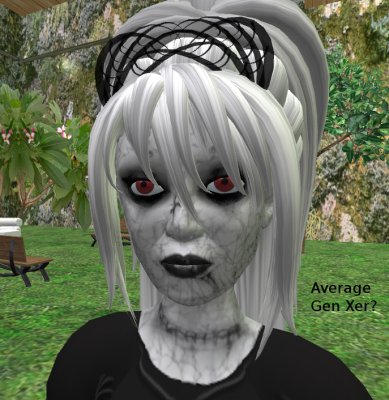When I started thinking about education in Second Life, and the reactions of students of university/college age to it, I rather naturally turned to think of my own experiences, and of ideas and prejudices I held as a student of approximately the same age. It took me a little time, and the reading of an article by Joe Essid and Lee Carleton, to realize that that particular approach was never going to work. Today’s students are, for the most part, not of my generation (Generation X), which typically includes folks born between 1964 and 1982. Instead, they tend to be those folks born between 1982 and 2002 or thereabouts – the Millennial Generation.
Why make this distinction? Each generation has a tendency to differ greatly from the generation directly preceding it (which is precisely why these otherwise seemingly arbitrary groupings are made). Ideas, political notions, morals and ethics all have a tendency to change, as the younger generation both learns from and rebels against the previous one. As Generation X rebelled against the strictures placed upon the Baby Boomers, so the Millennial Generation rebels in its quiet, refined manner against the excesses of Generation X.
In Second Life, the gap between Generation X and the Millennial Generation comes sharply into focus, in the two ways that I will discuss further:
1. Second Life is primarily filled with Generation X’ers, unintentionally creating a socially unwelcoming environment for Millennials;
2. Generation X’ers know how to play in the freeform manner that Second Life requires, whereas Millennials typically do not display that skill.
First, the social and political atmosphere of Second Life. Statistically, more people from Generation X participate in Second Life than from any other generation. The ramifications of this are two-fold. It’s harder for Millennials to make contact with other Millennials in this scene, since they constitute a minority of the population. Millennials no doubt feel somewhat uncomfortable interacting socially with folk outside their own generation, whether it be because they sense the cultural disconnect between themselves and older folk or for some other reason. Second Life is chock full Generation X’ers, and they have filled it with their own fashion sense, outlooks, learning styles, and politics – what an intimidating world to enter for the Millennials. Generations X’ers are the Millennials’ parents, and also those strangers their parents warned them about. Add to that the fact that the Millennials are much more likely to have many friends with whom they communicate face to face and then organize those friends and their own lives using technological gadgets and the Internet, rather than meeting people over the Internet. Second Life is simply an unfriendly place for you to go, even if you are not a typical, timid Millennial.
Second, Second Life is an environment in which you need to be able to set goals and tasks for yourself in order to get anything out of it – it is a non-directed playground in which to let the imagination run free. The Millennial Generation has not learned to play this way. They are not used to “making their own fun.” Throughout their schooling they have been given regimented tasks, with pre-determined goals; time outside school is often dominated by a flurry of parentally- determined activities. They are more likely to play games that are directed than to come up with their own games – a Millennial is more likely to play Guitar Hero than to spend time noodling about with a guitar.
The Millennial Generation has an overwhelming sense of ‘busyness’ that pervades their lives, so that not only is learning in a directed fashion a habitual thing for them, it’s also a way of doing things more quickly. Targeted exercises speed up the process of transmitting and garnering information. Additionally, students are looking to do close to the minimum of coursework required to pass, in order to spend more time socially with friends, a priority in this generation.
The educator who uses Second Life as a learning tool will be teaching an additional subject – how to play in a freeform way. The concept and practice of freeform or open-ended play was easier for Generation X, in a way – we were rebelling against another world entirely. Difference and imagination was embraced. It was like a little Renaissance. Even though our schooling focused somewhat on directed study, by university age we had hopefully been weaned off it – by the system. The Millennial Generation, however, needs now to be taught to play this way. They need to be drawn out of their risk-averse shells gently – they need to be led, not pushed. They are not bold.
Second Life is a place where the adventurous prosper and creativity is king – and being able to play in an open-ended way is a necessary skill. Educators need to accommodate their students by creating a somewhat directed environment for them to learn in, and then wean them off it and release them into the open.
For further information on this topic, check out “A Playful Pedagogy for Second Life“, Dr Joe Essid and Lee Carleton, 2008, to be published later this year.

Recent Comments